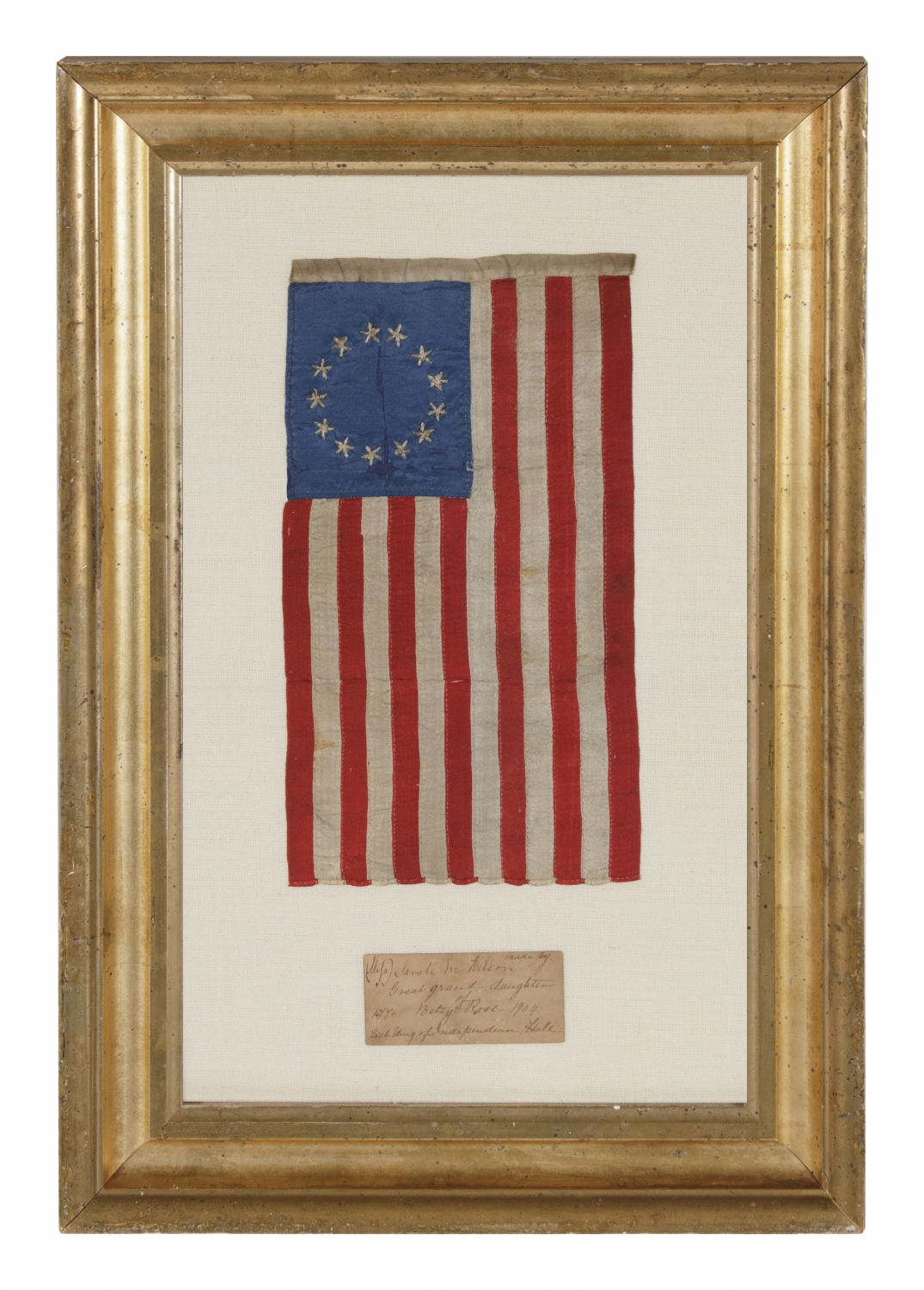
| |
13 HAND-EMBROIDERED STARS AND EXPERTLY HAND-SEWN STRIPES, ON A FLAG MADE BY SARAH M. WILSON, GREAT-GRANDDAUGHTER OF BETSY ROSS, IN PHILADELPHIA IN 1904 |
|
| Available: |
Sold |
| Frame Size (H x L): |
18.75" x 12.75" |
| Flag Size (H x L): |
flag - 10" x 5.5", note - 1.5" x 3" |
|
| Description....: |
|
13 star American national flag, entirely hand-sewn by Sarah M. Wilson, great-granddaughter of Betsy Ross. The stripes are constructed of silk ribbon carefully pieced with tiny stitches and a degree of precision seldom seen on American textiles. The five-pointed stars are executed with lineal lines like a spokes on a carriage wheel or the rowel of a spur. These are constructed of silk floss on a canton made of blue silk taffeta. The stripes of the flag are constructed of silk ribbon and hand-sewn with especially tiny stitches. The five-pointed stars are executed with lineal lines like a spokes on a carriage wheel or the rowel of a spur. These are constructed of silk floss on a canton made of blue silk taffeta. There is hand-sewn cotton binding along the hoist.
Beginning around 1898, Rachel Albright, Betsy’s granddaughter, began producing flags like this one in the East Wing of Independence Hall in Philadelphia. She sold them to tourists and probably sometimes gifted them to individuals who made donations to the American Flag House and Betsy Ross Memorial Association. She was elderly and sometime around 1902, as her health began to fail, she was joined by Sarah Wilson, Betsy's great-granddaughter, and the two women operated their tiny cottage industry until 1905, when Rachel relocated to Fort Madison, Iowa. She passed in 1907. Sarah continued in the trade until around 1913.
The Albright and Wilson flags are extraordinary because of their tiny size and silk, hand-sewn construction. They are extremely easy to identify because their characteristics are so distinctive. There is nothing else like them among 13 star flags made during this period. That having been said, they were individually made and do exhibit a small degree of personalized variation. The sleeves or hoist bindings vary in width and some have tiny, hand-sewn grommets.
The Wilson flags were sometimes signed along the hoist binding and sometimes not. When signed, they will have the following text: “Made by Sarah M. Wilson, Great grand-daughter of Betsy Ross; East Wing of Independence Hall Philadelphia,” followed by a date. They can also be found with hand-inscribed notes. This particular flag has a note the reads: “Made by Miss [note the long “S” Germanic] Sarah M. Wilson, Great-Granddaughter of Betsy Ross; 1776; 1904; East Wing of Independence Hall.” I used to think that the notes were more common, but the passage of time has taught me otherwise. Notes are few-and-far-between, probably existing with 5% or fewer of Sarah’s flags.
Rachael and Sarah proudly proclaimed that a circular wreath pattern was the design on the very first flag in 1776 [though the flag act wasn’t passed until 1777], but no hard evidence exists to substantiate what became family lore. In fact, no one knows precisely what the star configuration was on the first flag, but it is unlikely that it had a perfect circle of stars. Of the very few colonial examples that survive, none are in this pattern.
Further, while there are thousands of 13 star flags that still exist today, having been made during the 19th century for all manner of patriotic and utilitarian purposes, almost none made prior to the 1890’s survive that have their stars arranged in a “Betsy Ross”, perfect circle pattern. Circular patterns do appear in a couple of early illustrations, including one piece of American currency, but the Albright and Wilson flags are among the very first actual flags to be produced in this design and are probably responsible for the fact that this pattern is now so popularly connected with the Ross name. In other words, flags in this pattern made afterwards were probably copied from the Ross Granddaughter flags.
One of these small flags appears on the Betsy Ross House website (http://www.ushistory.org/betsy/house/room9.html). A signed example is picture in “The Stars and the Stripes” by Mastai, (1973, Knopf, New York), p. 228.
Mounting: The gilded, American molding is ca 1820-1860. This is a pressure mount between 100% hemp fabric and U.V. protective acrylic.
Condition: There is significant splitting in the canton with minor associated loss, accompanied by a slim nick along the top edge where it meets the stripe field. Fabric of similar coloration was placed behind the canton during the mounting process for masking purposes. There is minor soiling in the stripes. The note has oxidized to a golden brown. Many of my clients prefer early flags to show their age and history of use. |
|
|
|
| Collector Level: |
Advanced Collectors and the Person with Everything |
|
| Flag Type: |
|
|
| Star Count: |
13 |
|
| Earliest Date of Origin: |
1904 |
|
| Latest Date of Origin: |
1904 |
|
| State/Affiliation: |
Pennsylvania |
|
| War Association: |
|
|
| Price: |
SOLD |
|
| |
Views: 2106 |
|
|
|

